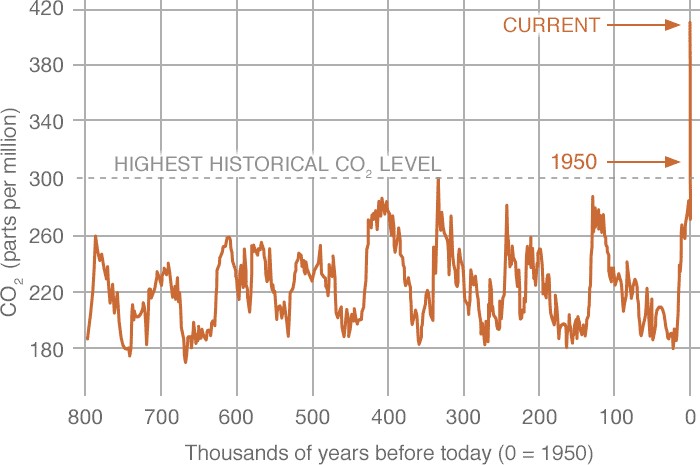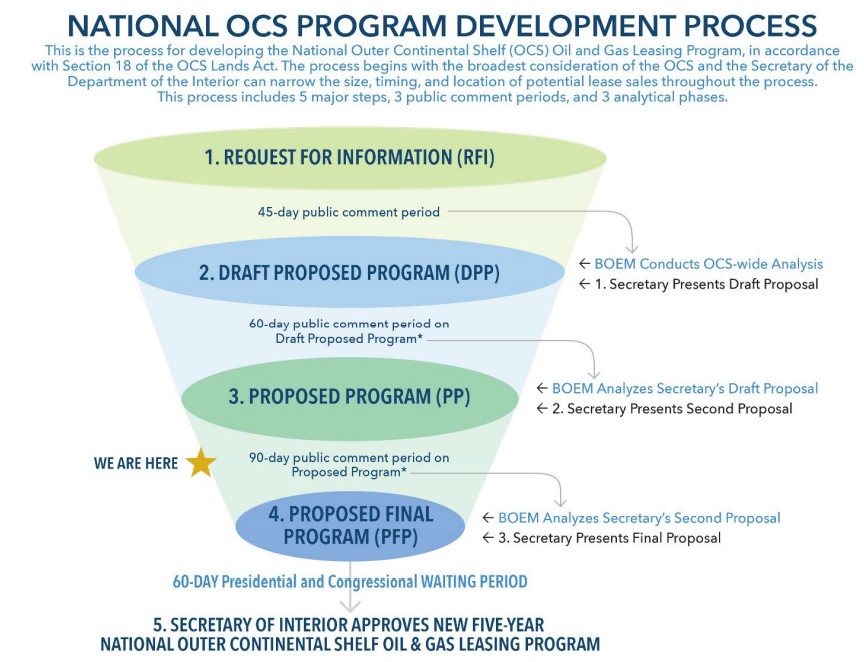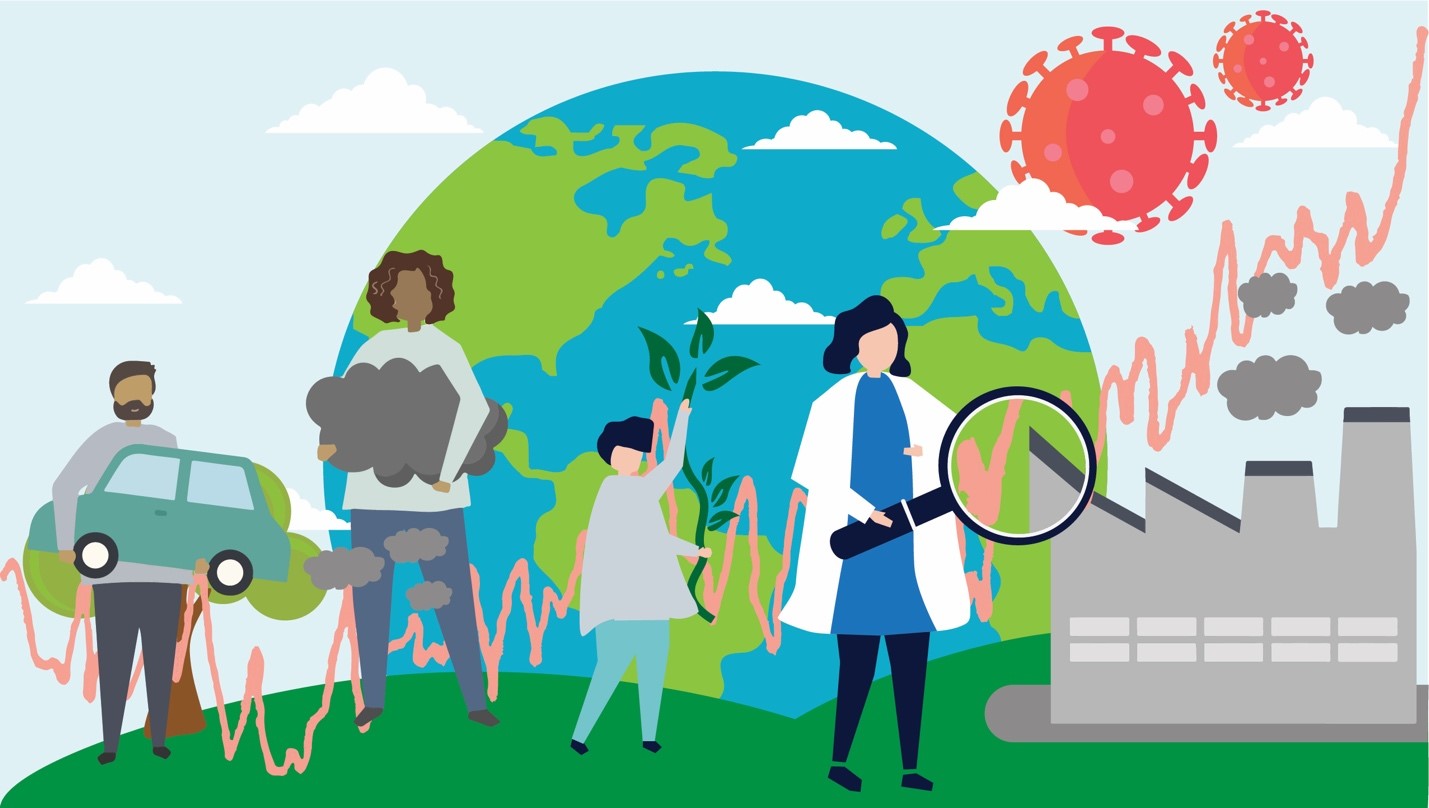Scientists have warned the public for years about the threat of climate change and have been met with little response. While many of us ignore what seems to be pessimistic white noise, it’s really a desperate cry for help, and experts can’t seem to grasp how it’s being so casually discounted. Sporadic reactions seem promising with every aesthetic infographic circulated around social media, but little action is taken. Even when the news shows koalas being narrowly saved from forest fires, the painfully beautiful colors emitted by corals in their hail-Mary attempt at avoiding death by UV rays, and the reports of people dying due to heat waves across the world, we see little to no concern from the public. Despite the knowledge we’ve acquired and the small number of individuals devoting their life to slowing the excessive warming of the planet, our Earth is still suffering. The alarming news that rising temperature predictions have not only been realized but have done so 30 years earlier than expected is feared to be indicative of the beginning of the end. It’s 2022, and in America, people are dying because of the heat.
The Earth Is Changing
Climate change, in and of itself, is not unnatural. The world is shifting constantly, and there is balance maintained by a steady oscillation between the extremes. Our planet travels through ice ages and heat waves, droughts, and floods, all while hosting life in the way only she can. But these changes don’t usually take place in the span of 50 or so years – they usually take millions. Since the dawn of the Industrial Revolution, the concentration of carbon dioxide gas in the atmosphere has been increasing. Still, today it is increasing at an almost greater than exponential rate. Emissions skyrocketed from nothing to suddenly being one of the primary products of human life on earth.

Fig. 1 shows the relationship between time and CO2 concentration in ppm. Notice how there is a regular pattern for hundreds of years up until around 1950, when the increase is higher than ever before and extremely steep.
Our meat production, transportation, textile manufacturing, coal burning, and oil drilling have all released energy that took the Earth millions of years to sequester and produce. Carbon dioxide is a greenhouse gas, meaning it traps heat within the Earth’s atmosphere, and this contributes to a warming planet. Again, Earth has been withstanding warming cycles for billions of years. Still, the abnormally rapid rate at which human activity has caused the heating to occur is so troublesome. It’s also this abnormally rapid heating that may be the very thing that renders Earth incapable of being called home by humanity. Carbon dioxide levels in the atmosphere did not exceed 300 ppm (parts per million) until 1950. For the past few billion years, an increase of about 100 ppm of CO2 might have taken about 50,000 years, but almost double that increase has occurred in just the past 70 years. The more CO2 in the atmosphere, the more heat is trapped on Earth. Life cannot evolve fast enough to survive such a drastic and rapid change in temperature.
All greenhouse gases, except the 11% produced by the agricultural industry, come from mining oil and gases, either through retrieving these resources or using their products. With these statistics showing such a heavy dependence on fossil fuels, we can’t even really say that we’re exploring other options. 60% of electricity in the United States comes from burning fossil fuels, and the pursuit of oil is not slowing down. Also, in the US, a quarter of greenhouse gases are produced directly by drilling. Offshore drilling has been of particular interest lately, with many of the oil spills, such as the Ixtoc I and Deep Horizon oil spills, being recorded as some of the largest in history, making bold headlines across the country and the world. Not only does offshore drilling, as evidenced by good compromises, immediately impact the environment, oceans, estuaries, coastal communities, and all the animals and people inhabiting these areas, but it also poses what we now know is a traditional role in the threat of accelerated climate change.
So, what plans do we have to mitigate climate change and its effects? Many scientists are experimenting with alternative energy sources, but progress is slow. Instead of making lasting changes, we lean on dogmas like “necessity breeds invention,” as if the passage of time will save us. At least, that’s how many people feel that the Department of the Interior has been behaving thus far, with their most prominent solution being to raise oil fees and the prices of drilling site leases. Now, the opportunity for real progress has presented itself, with the Department of the Interior releasing a Proposed Program that decreased the amount of offshore drilling lease sales for the years 2023-2028 from 47 to 11. This would effectively eliminate federal waters off the Atlantic and Pacific coasts as offshore drilling sites, a step in the right direction towards utilizing cleaner sources for our country’s energy needs. Even better, the DOI is opening up the remaining ten possible lease sites to public opinion and are even asking for help.
The Department of the Interior was established to manage America’s natural resources and specializes in promoting environmental justice, stewarding public lands, and protecting and honoring agreements with Native tribes across the U.S. Under the DOI is the Bureau of Ocean Management, which is supposed to facilitate the management of energy resources in the Outer Continental Shelf and is responsible for all leasing policies associated with oil, gas, and marine minerals associated with the OCS. The aim of both of these organizations is to be more environmentally considerate while fulfilling their responsibilities. With the state of greenwashing today, we must ask, are these departments as eco-conscious as they claim to be?
What Are We Doing
While the U.S. has fallen short in mitigating climate change – from exiting the COP26 agreements to having a fair novice recycling infrastructure – the arguable beauty of this country lies in the people’s power to voice their opinion. The ugly part, however, is that these opportunities to be heard aren’t well advertised. Every five years has an established schedule of proposed lease sales.

Fig. 2 The steps towards a lease proposal becoming finalized. The star indicates the stage we are currently in for the 2023-2028 plan.
The DOI drafts a new plan every five years in which they outline what parts of the OCS will be leased and which leases (plots of acreage up for grabs that drilling companies can essentially rent while they explore or retrieve product from) will be continued or discontinued. Under the OCS Lands Act, which contains rules and guidance that are supposed to consider the environmental impacts of drilling, the Secretary of the Interior is tasked with picking the size and locations of these sites, supposedly keeping in mind adverse coastal implications and the potential for environmental damage. The leases are considered, and a plan is put in place, though the plan’s drafting has a specific process. It starts with the BOEM doing an analysis that leads to a Draft Proposal Program.
After this, public comment is allowed, and the BOEM examines the proposal. From here, a second proposal called the Proposed Program is written, again granted public comment and analyzed once more before becoming the Proposed Final Program. As of today, we are approaching this final stage quickly. A notice for the solicitation of public comment has already gone out, with four virtual public hearings scheduled and a deadline of October 6th for written comment submission. With the future of the Earth’s climate hanging in the balance, one may beg the question, why is the public’s ability to have a say in the future of oil and drilling not well-publicized considering how seemingly accessible it is? This problem seems to be met with a response not nearly as intense of that which is warranted.
The Proposed Program essentially outlines potential lease sales for further gas and oil drilling in the Outer Continental Shelf. Subject to, “further analysis and public opinion,” there is a current list of 11 sites – 10 in the Gulf of Mexico and 1 in Alaska – that could be leased out in 2023-2028. If chosen to be used, these sites would follow a lease schedule also included in the proposal, with about two sites leased per year. This is a vast improvement from previously having 47 sites in consideration, and the fact that the sites aren’t all going to be leased out all at once but instead staggered every two years is also helpful. However, when the proposal states that the Alaska site is claimed to be surrounded by productive leases, yet another question arises, what do the Department of the Interior and the Bureau of Ocean management consider productive? As of August 2022, there are 0 producing (yielding oil or gas) active leases in the Alaskan site, Cook Inlet, that is referenced in the proposal.
Furthermore, when discussing the site close to Cook Inlet, the Beaufort Sea, only 50% of its active leases are productive. Likewise, in the Gulf of Mexico, which is stated to be the source of 95% of the entire Outer Continental Shelf’s production, only around 25% of the acreage being drilled in the active leases is yielding oil. Given the direct environmental impact risks of drilling, we should consider halting exploratory drilling where yield from proximal sites is low. However, this can be difficult. We have an entire country’s economy to consider and the lives of millions who still rely heavily on fossil fuels in the face of an inadvertent, unpromising thus far, electric future.
The Voice of Change
This is where the public comes in. The Proposed Program includes an acknowledgment of the necessity of public comment and even goes as far as requesting it. The Proposed Program states that if we do indeed progress globally towards decarbonization more quickly than projected, maybe pursuing none of the proposed lease sites would be the best move – environmentally and economically- as funding entirely new infrastructure for some of these sites that have never been drilled is no cheap feat. The current lease sites are primarily a result of our inability to make the switch to clean energy by now. Still, we are hopeful that technology does advance in the next five years – and if the next five years proves to be very fruitful, then leasing more drilling sites would be pointless and wasteful in hindsight. The draft states, “In the absence of adequate data at this stage of the Program’s development, BOEM has not performed a quantitative net benefits analysis that assumes a net-zero emissions pathway. The agency seeks feedback on the qualitative assessment … which considers changes in anticipated production, substitutions, and impacts ... BOEM is specifically interested in any potential data sources sufficient for BOEM’s modeling that could help enhance the model and better reflect assumptions associated with a transitioning economy.” The BOEM admits their knowledge gaps, something we don’t often see from government organizations and big corporations.
This knowledge, like any political decision making on the line, is useless without action. As citizens of not only the U.S. but also the globe, it is our responsibility to care for our planet and her ecosystems. Climate change is imminent, and the threat is very scary and real. But we can make a difference as long as we act now. For some of us, the action looks like educating the public, spreading awareness, correcting skewed understandings, and doing research. For others, it can look like protests, devoting time to non-profits, and engaging in community initiatives. If you feel so led to have your activism grace the political scene, here are a few things you can do:
What Can You Do
Join the BOEM for Virtual Open House Meetings to ask questions about and provide feedback for their leasing proposals and speak directly to the BOEM in an open-house style. Meetings are over zoom, with current dates listed as August 23rd, 25th, 29th, and 31st. Find information about meeting times and how to access them by clicking here.
You can become better acquainted with the Proposed Program and the Draft Programmatic Environmental Impact Statement and then submit a written public comment for consideration. You can visit this page to learn more and submit your own comment. Comments will be welcomed until the deadline of October 6th, 2022.
If you want to see the leasing program halted altogether, sign Surfrider’s petition to keep drilling out of the Outer Continental Shelf! Sign now to add your name to their petition to Protect U.S Waters from New Oil and Gas Leases.
References:
Adamson, R. (2022, August 4). Intense but short-lived heat wave to Broil Northeast. AccuWeather. Retrieved August 23, 2022, from https://www.accuweather.com/en/weather-forecasts/intense-but-short-lived-heat-wave-to-broil-northeast/1227430
Biello, D. (2015, May 20). BP oil spill responsible for Gulf of Mexico Dolphin deaths. Scientific American. Retrieved August 25, 2022, from https://www.scientificamerican.com/article/bp-oil-spill-responsible-for-gulf-of-mexico-dolphin-deaths/
BOEM. (2022, August). Combined Leasing Report. Sites. Retrieved August 25, 2022, from https://www.boem.gov/sites/default/files/documents/regions/pacific-ocs-region/oil-gas/Lease%20stats%208-1-22.pdf
BOEM, DOI. (2022, July). 2023–2028 National OCS Oil and Gas Leasing Program draft programmatic ... BOEM. Retrieved August 25, 2022, from https://www.boem.gov/sites/default/files/documents/oil-gas-energy/national-program/2023-2028NationalOCSOilGasLeasingDraftPEISVol2.pdf
Bureau of Ocean Energy Management, & Lewandowski, J., 2023-2028 National OCS Oil and Gas Leasing Program Draft Programmatic Environmental Impact Statement i-ix (20166). Sterline, VA; BOEM.
Bureau of Ocean Energy Management. (2022). Leasing. Retrieved August 25, 2022, from https://www.boem.gov/oil-gas-energy/leasing
Davenport, C., & Friedman, L. (2021, November 26). Interior Dept. report on drilling is mostly silent on climate change. The New York Times. Retrieved August 25, 2022, from https://www.nytimes.com/2021/11/26/climate/climate-change-drilling-public-lands.html#:~:text=The%20United%20States%20Geological%20Survey,that%20are%20warming%20the%20planet.
DOI. (2022, March 30). About Interior. U.S. Department of the Interior. Retrieved August 25, 2022, from https://www.doi.gov/about
Earth Science Communications Team. (2022, August 23). Climate change evidence: How do we know? NASA. Retrieved August 23, 2022, from https://climate.nasa.gov/evidence/
Environmental Protection Agency, U. S. (2022, May 16). Overview of Greenhouse Gases. EPA. Retrieved August 23, 2022, from https://www.epa.gov/ghgemissions/overview-greenhouse-gases#:~:text=Carbon%20dioxide%20(CO2)%20is,gas%20emitted%20through%20human%20activities.
Future Weather Forecast for the year 2050. (2020). Met Office. Retrieved August 23, 2022, from https://www.metoffice.gov.uk/services/insights/future-weather-forecast-for-2050.
Interior Department Invites Public Comment on Proposed Five Year Program for Offshore Oil and Gas Leasing. (2022, July 1). Press Releases. Retrieved August 25, 2022, from https://www.doi.gov/pressreleases/interior-department-invites-public-comment-proposed-five-year-program-offshore-oil-0.
Jacobo, J. (2022, August 1). Heat suspected as cause of 10 fatalities following Pacific Northwest heat wave. ABC News. Retrieved August 23, 2022, from https://abcnews.go.com/US/heat-suspected-10-fatalities-pacific-northwest-heat-wave/story?id=87750020
Lee, H. (2021, April 15). How Earth's climate changes naturally (and why things are different now). Quanta Magazine. Retrieved August 23, 2022, from https://www.quantamagazine.org/how-earths-climate-changes-naturally-and-why-things-are-different-now-20200721/
Mcclanahan, P. (2022, August 4). Stockholm instead of Rome? October instead of July? how heat waves are changing tourism in Europe. The New York Times. Retrieved August 23, 2022, from https://www.nytimes.com/2022/08/04/travel/heat-wave-europe.html
Merrill, M. D., Sleeter, B. M., Freeman, P. A., Liu, J., Warwick, P. D., & Reed, B. C. (2018, November 23). Federal lands greenhouse gas emissions and sequestration in the United States: Estimates for 2005–14. Scientific Investigations Report. Retrieved August 25, 2022, from https://pubs.er.usgs.gov/publication/sir20185131
Office of Public Affairs. (2011, September 14). Deepwater Horizon Joint Investigation Team Releases Final Report. BOEMRE Press release. Retrieved August 25, 2022, from https://web.archive.org/web/20110924075744/http://www.boemre.gov/ooc/press/2011/press0914.htm
Rush, C. (2022, August 3). Pacific Northwest Heat Wave suspected as cause of 14 deaths in Oregon, officials say. USA Today. Retrieved August 23, 2022, from https://www.usatoday.com/story/news/nation/2022/08/02/heat-wave-deaths-oregon-authorities-investigate/10210919002/
The making of the future weather forecast for 2050. (2020). Met Office. Retrieved August 23, 2022, from https://www.metoffice.gov.uk/services/insights/the-making-of-the-future-weather-forecast-for-the-year-2050.
Writers, S. (2022, August 22). Climate change - rising temperature. PublicHealth.org. Retrieved August 23, 2022, from https://www.publichealth.org/public-awareness/climate-change/



